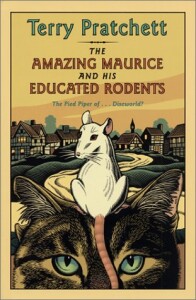 The immensely popular Discworld series has its first entry in the field of young readers’ books with The Amazing Maurice. It’s a mostly successful effort, built on Terry Pratchett’s brand of satiric humor, which here is toned down a bit for the young reader.
The immensely popular Discworld series has its first entry in the field of young readers’ books with The Amazing Maurice. It’s a mostly successful effort, built on Terry Pratchett’s brand of satiric humor, which here is toned down a bit for the young reader.
Discworld, for the unenlightened, is a flat planet peopled by all manner of creatures from Earth’s fantasy realms: ogres and trolls, dwarves and elves, wizards and martial-arts masters, as well as regular folk who are mostly dense and bumbling or bright and bumbling. It resembles the multiverse envisioned by Robert Heinlein in The Number of the Beast, in which a new parallel universe was created every time a human writer created a fantasy world. Thus, you had universes in which the Wizard of Oz and all of Baum’s characters lived, and others peopled by Tolkien’s Hobbits and so on. But they’re all jumbled together on Discworld.
The Amazing Maurice is a retelling of the Pied Piper legend (in fact the subtitle is The Pied Piper of … Discworld?), told in Pratchett’s typically skewed way.
Maurice is a cat, and His Educated Rodents are rats, all of whom have somehow become “people.” They can think and talk, and many have even taught themselves to read humans’ books. They have recruited a “stupid-looking kid” who plays the tin whistle, and they go from town to town working their scam. The rats display themselves prominently in peoples’ kitchens, pantries and barns, widdling in the cream, widdling in the flour, widdling in the wheat (Pratchett knows his audience’s appetite for toilet humor), and occasionally tap-dancing across the parlor floor. Then the kid shows up with his whistle, plays his tune and dances the rats out of town, where they meet up with Maurice (the brains of the outfit) and split the money three ways.
The rats seem to have gotten their powers from eating the garbage on a rubbish heap outside of the Wizards’ Academy. Maurice isn’t talking about where he got his; well, he is, if you listen closely. And the rats have taken their names from the discarded food tins in the tip (or dump as we’d say in America). So they have monikers like Peaches, and Sellby, and Hamnpork, and Big Savings, and Sardines, and Dangerous Beans (did I mention the toilet humor?).
Their big adventure comes when they hit the town of Bad Blintz, where some crooked human rat catchers already have their own scam under way. Maurice and the stupid-looking kid, whose name turns out to be Keith, meet Malicia, the mayor’s daughter, an annoying know-it-all who expects life to be like the adventure stories she reads.
Pratchett has great fun satirizing various fairy tale and adventure story conventions, but he seems to fall into one or two of them himself, particularly the one-dimensional portrait of the girl Malicia. And there’s very little in the book’s plot or devices that mark it as especially Discworld-like; it could just as easily be set in any generic fantasy land.
But mostly The Amazing Maurice is an entertaining read, and it aims to instill wholesome values like teamwork and tolerance and friendship and fair play, all the while seeming to be mildly subversive — perfect for the Harry Potter age group. Consider this one for any nieces and nephews and such in the next holiday season of your choice.
(HarperCollins, 2001)
